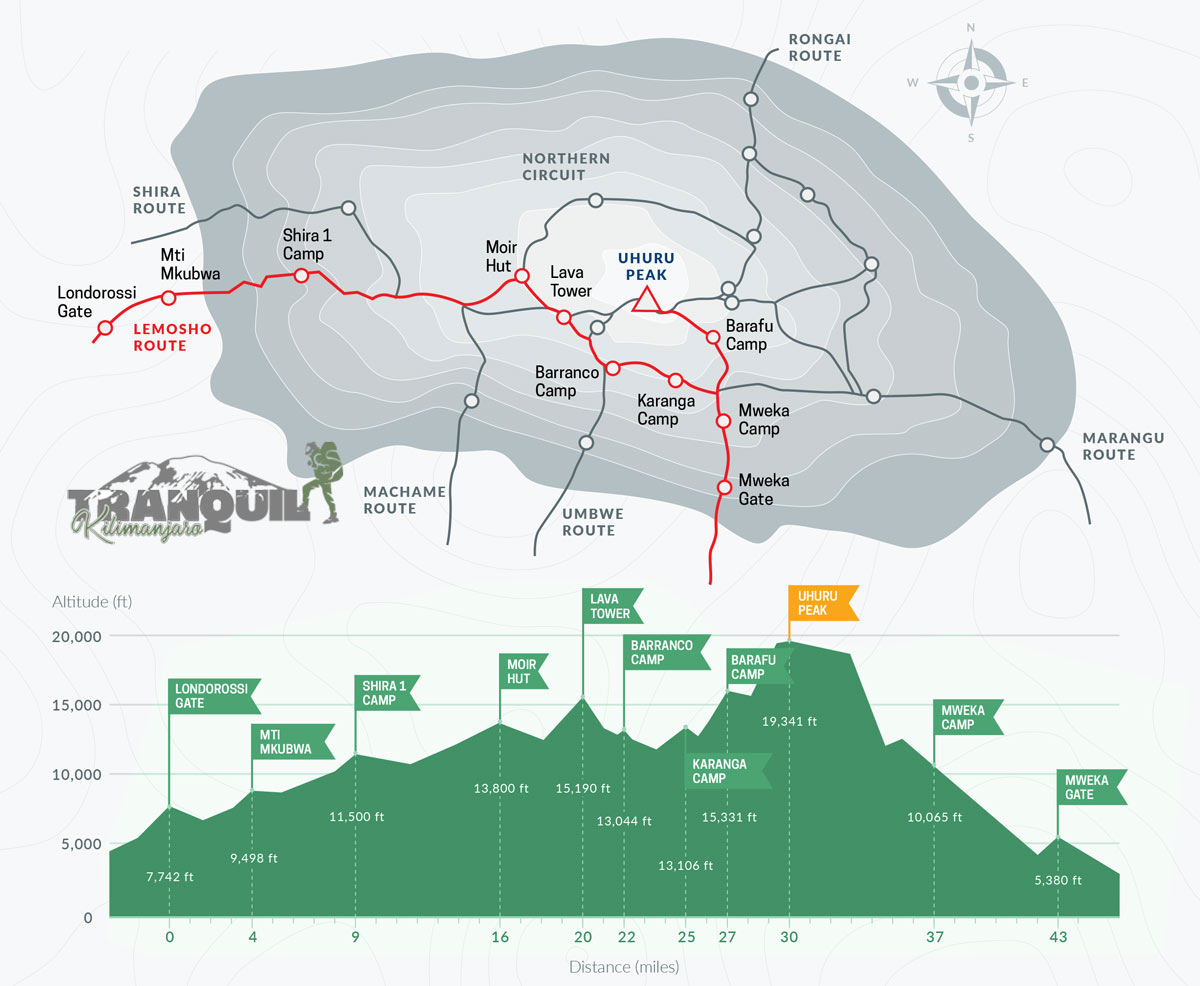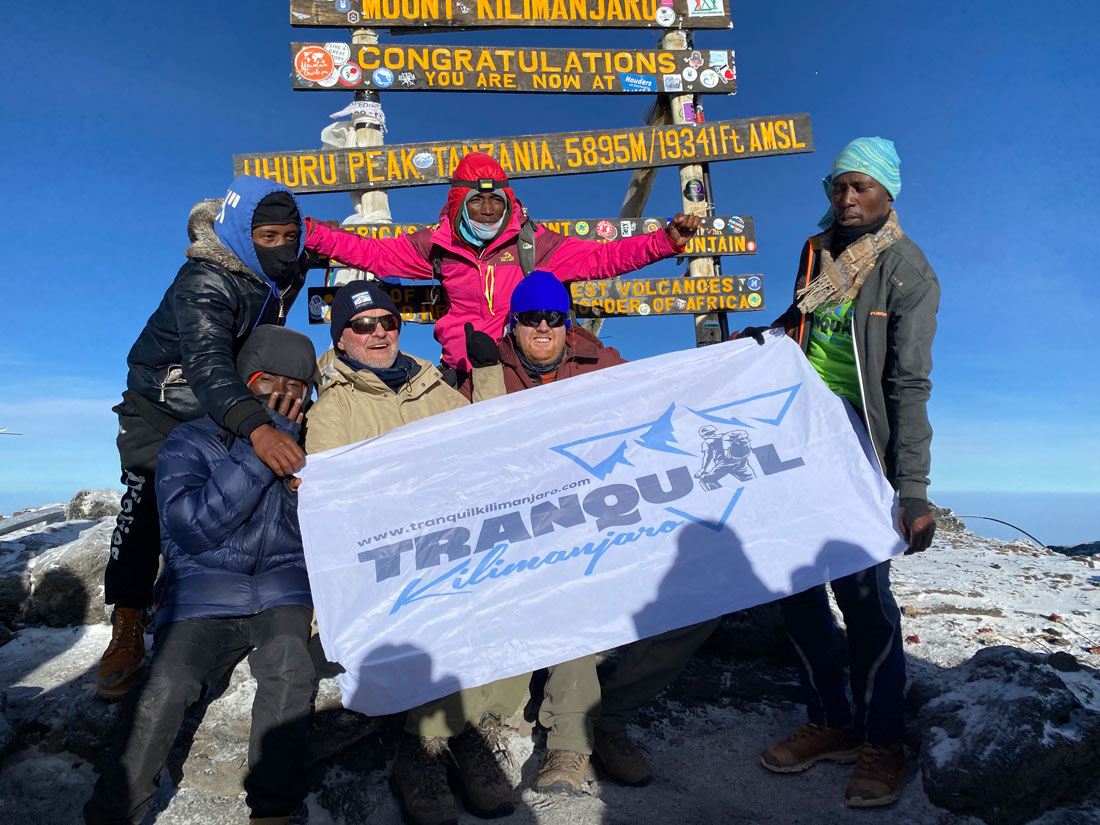The Lemosho Route stands as one of the most picturesque and diverse trails for ascending Mount Kilimanjaro. Its popularity stems from its scenic beauty, varied terrain, and high success rates. When embarking on this journey, trekkers are faced with the decision between the 7-day and 8-day itineraries, each offering unique advantages and challenges. The main difference between these two variations lies in the number of days spent on the mountain, the pricing, and that extra acclimatization day at Karanga Camp on the seventh day of the 8-day trek. Click here to see what Karanga Camp looks like. Tranquil Kilimanjaro always advises our clients and anybody wishing to climb Kilimanjaro to opt for the 8-day variation, meaning an 8-day climb can have a 90% or greater summit success rate. For each day you subtract from your itinerary, the summit success rate drops by 20%. So for a 7-day climb, your success rate would be around 70%.
 Lemosho Route Overview
Lemosho Route Overview
The Lemosho Route spans approximately 65 kilometers (40 miles) in length, meandering through lush rainforests, expansive moorlands, and rugged alpine deserts. Its gradual ascent profile allows for optimal acclimatization, enhancing the chances of a successful summit bid. The route is renowned for its stunning vistas, including panoramic views of the surrounding landscapes and glimpses of Kilimanjaro’s iconic glaciers.
In terms of difficulty, both the 7-day and 8-day itineraries are considered challenging due to the high altitude and variable weather conditions. However, the gradual ascent of the Lemosho Route provides trekkers with ample time to acclimatize, reducing the risk of altitude-related complications.
Read more about the Lemosho Route
The 7 Days Lemosho Route Trek
The 7-day Lemosho Route itinerary is designed for those seeking a slightly more expedited trekking experience. It typically follows the following breakdown:
- Day 1: Arrival at Kilimanjaro International Airport, transfer to hotel in Moshi.
- Day 2: Registration and briefing at the Kilimanjaro National Park gate, trekking through lush rainforests to Mti Mkubwa Camp.
- Day 3: Ascend through the rainforest to Shira 1 Camp, passing through the magical Heath Zone.
- Day 4: Trekking across the Shira Plateau to Shira 2 Camp, with stunning views of the surrounding landscapes.
- Day 5: Progressing through the alpine desert to Barranco Camp, navigating the challenging Barranco Wall en route.
- Day 6: Traverse the Karanga Valley to Karanga Camp, ascending towards the Barafu Camp.
- Day 7: Summit night ascent to Uhuru Peak, the highest point in Africa, and descend to Mweka Camp.
Each day presents its own set of highlights and challenges, from the enchanting rainforests of the lower slopes to the breathtaking views from the summit. Trekkers should maintain a good level of fitness and be prepared for long days of hiking at high altitudes.
See the full 7 day Lemosho Route itinerary here
The cost of climbing Kilimanjaro via the Lemosho route – seven days is as follows.
1 Person: $2,950
A group of 2 people: $2,435 per person
A group of 3 people: $2,318 per person
A group of 4 people: $2,295 per person
A group of 5 people: REQUEST PRICE
A group of 6 People: $2,165 per person
A group of 7+ people: REQUEST PRICE
Note: Prices are subject to change and may vary depending on specific requirements and additional services requested. Please contact us for pricing for groups of 5 people or 7 or more people.
The 8 Days Lemosho Route Trek
The 8-day Lemosho Route itinerary offers an additional day for acclimatization, increasing the chances of a successful summit bid and reducing the risk of altitude sickness. The itinerary typically unfolds as follows:
- Day 1-6: Follows the same itinerary as the 7-day trek, allowing for a more relaxed pace and additional time for acclimatization.
- Day 7: Rest day at Karanga Camp, allowing trekkers to acclimatize further and recharge for the summit push.
- Day 8: Summit night ascent to Uhuru Peak, followed by the descent to Mweka Camp.
The additional acclimatization day at Karanga Camp is a key highlight of the 8-day itinerary, providing trekkers with a chance to adjust to the altitude before the final ascent. This extra day can significantly improve the overall trekking experience and increase the likelihood of reaching the summit.
See the full 8 day Lemosho Route itinerary here
The cost of climbing Kilimanjaro via the Lemosho route – eight days is as follows.
1 Person: $3,115
A group of 2 people: $2,750 per person
A group of 3 people: $2,650 per person
A group of 4 people: $2,440 per person
A group of 5 people: REQUEST PRICE
A group of 6 People: $2,350 per person
A group of 7+ people: REQUEST PRICE
Comparison
The main differences between the 7-day and 8-day itineraries lie in the pace of the trek and the level of acclimatization. The 7-day itinerary offers a more expedited ascent, while the 8-day itinerary allows for a more gradual approach, reducing the risk of altitude-related complications.
In terms of overall trekking experience, both itineraries offer unparalleled opportunities for adventure and discovery. Personal preferences, fitness levels, and previous trekking experience should all be taken into account when choosing between the two options.
The main differences.
In conclusion, the Lemosho Route presents an extraordinary opportunity to summit Mount Kilimanjaro, offering stunning scenery and a challenging yet rewarding trekking experience. Whether opting for the 7-day or 8-day itinerary, careful consideration of individual preferences and fitness levels is essential. By choosing the right itinerary and adequately preparing for the journey ahead, prospective trekkers can maximize their chances of a successful summit bid and create memories to last a lifetime.
The Lemosho route is one of the popular trails for climbing Mount Kilimanjaro, offering stunning scenery and excellent acclimatization opportunities. While both the 7-day and 8-day Lemosho routes lead climbers to the summit of Kilimanjaro, there are some key differences between the two in terms of duration, itinerary, and acclimatization.
Duration:
- 7-Day Lemosho Route: This route typically takes 7 days to complete, including 6 days of trekking and 1 day for descending from the summit. It is a relatively shorter option compared to the 8-day route. Join the 8 day Lemosho Route group trek on a full moon here
- 8-Day Lemosho Route: As the name suggests, this route spans over 8 days, providing an additional day for acclimatization and a more gradual ascent. This longer duration allows for a slower pace, reducing the risk of altitude sickness and increasing the chances of successfully reaching the summit. Join the 7 day Lemosho Route group trek here
Itinerary:
- 7-Day Lemosho Route: The 7-day itinerary follows a slightly faster pace, with fewer days for acclimatization. While it covers the same trail as the 8-day route, it may involve longer hiking days and less time for rest and acclimatization at higher altitudes.
- 8-Day Lemosho Route: The 8-day itinerary includes an extra day for acclimatization at the Shira Camp or Barranco Camp, depending on the specific itinerary. This additional day allows climbers to gradually adjust to the altitude, reducing the risk of altitude-related illnesses and increasing the chances of summit success.
Acclimatization:
- 7-Day Lemosho Route: Due to the shorter duration, climbers on the 7-day route have less time to acclimatize to the high altitude. While the route still includes gradual altitude gains, some individuals may find it challenging to adjust to the thin air at higher elevations.
- 8-Day Lemosho Route: With an extra day built into the itinerary specifically for acclimatization, climbers on the 8-day route have a better chance of adapting to the altitude. This additional day allows the body to adjust more gradually, reducing the risk of altitude sickness and improving overall well-being during the trek.
The main difference between the 7-day and 8-day Lemosho routes lies in the duration and acclimatization strategy. While both routes lead to the summit of Mount Kilimanjaro, the 8-day route offers a more gradual ascent and additional time for acclimatization, making it a popular choice for climbers seeking a safer and more comfortable trekking experience.
![]()

 Lemosho Route Overview
Lemosho Route Overview
Comments